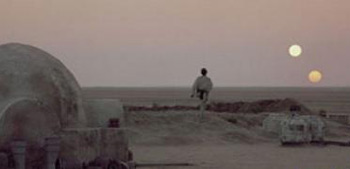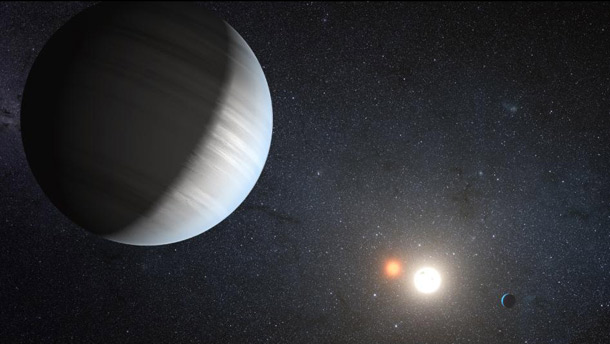Create a free profile to get unlimited access to exclusive videos, sweepstakes, and more!
Kepler finds a planet in a binary star's habitable zone

Oh, this is too cool: scientists have found a planet orbiting a binary star (a pair of stars in tight orbit around each other) that is at the right distance to have liquid water! Let me be clear: this planet is much bigger than Earth, and is likely to be a gas giant. So it's not Earth-like, and probably not itself habitable.
But it might have moons...
[Note: this image is artwork based on the science. Click to tatooineneate.]
OK, first: Kepler is an orbiting telescope that has been staring at one spot in the sky for about three years now. It's looking at about 100,000 stars. If these stars have planets, and the orbits of these planets are seen edge-on, then they will occasionally pass directly between us and their parent star blocking a little bit of the light. This is called a transit, and if the planet is big enough it can block enough light from the star to be detected by Kepler. So far, 77 planets have been confirmed using Kepler, and over 2000 more have been detected and are awaiting confirmation.
The new discovery deals with a binary star called Kepler-47. It's about 5000 light years away, which is pretty far for a Kepler system - it's faint at that distance. Still, the observations look very good, and the conclusions convincing to me.
One of the two stars is very Sun-like, about the same size, temperature, and brightness as our home star. The second is fainter, smaller, and cooler. They comprise an eclipsing binary: their orbit is seen edge-on from Earth, so they pass in front of each other as seen by us as they circle each other. Their orbit is pretty tight: they're only about 13 million kilometers (8 million miles) from each other, and their orbit is just 7.5 days long.
Two planets were actually found orbiting the stars. Kepler-47b is about 3 times the diameter of the Earth. Its mass isn't known, but it's likely 7 - 10 times ours. It's hot: the orbit is just 50 million km (30 million miles) out, closer than Mercury is to the Sun. It takes about 50 days to orbit.
The second planet, Kepler-47c, is the interesting one. It's even bigger, 4 - 6 times Earth's diameter, roughly the size of Uranus, and most likely 20 times our mass. Its orbit is almost exactly the same size as Earth's, coincidentally, taking 300 days to orbit the binary (its year is shorter than ours because the two stars together have more mass, and therefore more gravity, than the Sun).
Taking into account the orbital size and the physical properties of the stars, the scientists have determined that the planet is at the right distance to be in the stars' habitable zone: the distance where liquid water could exist on a solid body.
As I pointed out, the planet is probably a gas giant. But it could have moons - in fact, given our own solar system configuration, it seems likely. It's not crazy to think that these moons, should they exist, might be habitable. That's amazing.
 These two new worlds put the roster of confirmed circumbinary planets (that is, planets orbiting binary stars) to six. And we only just started looking a few years ago! Given the number of stars observed and the planets found, and applying a little statistics, it seems entirely possible that there are millions of such planets in our Milky Way galaxy alone.
These two new worlds put the roster of confirmed circumbinary planets (that is, planets orbiting binary stars) to six. And we only just started looking a few years ago! Given the number of stars observed and the planets found, and applying a little statistics, it seems entirely possible that there are millions of such planets in our Milky Way galaxy alone.
That's right: millions of possible Tatooines just waiting to be found! And we may yet find them. Finding gas giant planets is far easier than finding their much smaller moons, but one of the goals of exoplanet astronomy is to improve the technology and the techniques to the point where such moons can be detected as well. It may take bigger telescopes and more time, but there is nothing stopping us except our will to do so.
Think of that: we can detect potential Earths around stars quadrillions of kilometers away! And all we have to do is want it enough.
[P.S. If you want to keep up with exoplanet news, there's a wonderful iPhone/iPad app called Exoplanet that has info, diagrams, and updates when new planets are found. I use it myself and really like it.]
Image credit: NASA/JPL-Caltech/T. Pyle
Related Posts:
- Astronomers discover a wretched hive of scum and villainy
- Exoplanet news Part 4: More wretched hives of scum and villany
- No, thatâs not a picture of a double sunset on Mars
- New study: 1/3 of Sun-like stars might have terrestrial planets in their habitable zones



























